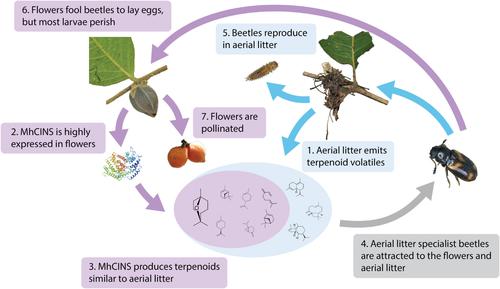Our official English website, www.x-mol.net, welcomes your
feedback! (Note: you will need to create a separate account there.)
Aerial litter mimicry: A novel form of floral deception mediated by a monoterpene synthase
Journal of Ecology ( IF 5.3 ) Pub Date : 2024-11-11 , DOI: 10.1111/1365-2745.14446 Ming‐Fai Liu, Junhao Chen, Katherine R. Goodrich, Sung Kay Chiu, Chun‐Chiu Pang, Tanya Scharaschkin, Richard M. K. Saunders
Floral mimics deceive their pollinators by developing visual and olfactory resemblance to various models. We report a flower that exhibits phenotypes like aerial litter and deceives an aerial litter specialist beetle to achieve pollination. We assessed the floral phenology and the effective pollinators of an Australian understorey treelet, Meiogyne heteropetala (Annonaceae). The similarities of morphology, colour and odour between the flowers and co‐occurring aerial litter were investigated. The terpene synthase involved in floral scent emission was identified by expression patterns and product profile. The behavioural responses of the pollinator to various odours were assessed using bioassays. The erotylid beetle Loberus sharpi is the most likely effective pollinator because it was the only pollen‐laden visitor during the pistillate phase. Loberus sharpi was exclusively found in aerial litter and M. heteropetala flowers. The flowers offer an honest shelter reward. The beetle also oviposits there, but most larvae eventually perished as the petals dropped onto the forest floor. The morphology and spectral reflectance of the flowers overlap with aerial litter. The floral scent was dominated by monoterpenes, especially 1,8‐cineole. The cineole synthase MhCINS was the only highly expressed floral terpene synthase and possessed a highly similar product profile to the floral scent composition. The volatile composition of M. heteropetala flowers is distinct from other congeners and highly similar to aerial litter, indicating advergence to aerial litter. Visual and odour resemblance, coupled with low larval survivorship, provides evidence that the beetles were deceived into pollinating the flowers. Behavioural experiments showed that the pollinator was attracted to both aerial litter and M. heteropetala flowers. The beetles were also attracted to 1,8‐cineole and synthetic mixes of floral odour and MhCINS products. The beetles were unable to distinguish floral scent from MhCINS products nor from 1,8‐cineole, suggesting MhCINS alone sufficed to attract the pollinator olfactorily. The beetles, however, preferred aerial litter over flowers. The beetles likely categorised the flower as a general, but not the most preferred, brood substrate. Synthesis. This study reports the first case of floral mimicry of aerial litter and characterises the biochemical process responsible for olfactory mimicry.
中文翻译:

空中凋落物模拟:一种由单萜合酶介导的新型花欺骗
花卉模仿者通过发展与各种模型的视觉和嗅觉相似性来欺骗它们的传粉者。我们报道了一种花,它表现出像空中垃圾这样的表型,并欺骗了空中垃圾专业甲虫来实现授粉。我们评估了澳大利亚林下小树 Meiogyne heteropetala (Annonaceae) 的花物候和有效传粉媒介。研究了花朵和同时发生的气生垃圾之间的形态、颜色和气味的相似性。参与花香排放的萜烯合酶通过表达模式和产品特征进行鉴定。使用生物测定法评估传粉者对各种气味的行为反应。erotylid beetle Loberus sharpi 是最有可能有效的传粉者,因为它是雌蕊阶段唯一充满花粉的访客。Loberus sharpi 仅存在于气生凋落物和 M. heteropetala 花中。这些花提供了诚实的庇护所奖励。甲虫也在那里产卵,但大多数幼虫最终随着花瓣落到森林地面上而死亡。花的形态和光谱反射率与空中垃圾重叠。花香以单萜类为主,尤其是 1,8-桉树脑。桉树脑合酶 MhCINS 是唯一高度表达的花萜烯合酶,具有与花香成分高度相似的产品特征。M. heteropetala 花的挥发性组成与其他同类不同,与空气凋落物高度相似,表明倾向于空气凋落物。视觉和气味的相似性,加上幼虫存活率低,提供了甲虫被欺骗为花朵授粉的证据。 行为实验表明,传粉者被空中垃圾和 M. heteropetala 花所吸引。甲虫还被 1,8-桉树脑和花香和 MhCINS 产品的合成混合物所吸引。甲虫无法区分花香与 MhCINS 产品或 1,8-桉树脑,这表明仅靠 MhCINS 就足以在嗅觉上吸引传粉者。然而,比起花朵,甲虫更喜欢空中垃圾。甲虫可能将花归类为一般的,但不是最受欢迎的育雏基质。合成。本研究报告了第一个空气垃圾的花模拟病例,并描述了负责嗅觉模拟的生化过程。
更新日期:2024-11-11
Journal of Ecology ( IF 5.3 ) Pub Date : 2024-11-11 , DOI: 10.1111/1365-2745.14446 Ming‐Fai Liu, Junhao Chen, Katherine R. Goodrich, Sung Kay Chiu, Chun‐Chiu Pang, Tanya Scharaschkin, Richard M. K. Saunders

|
中文翻译:

空中凋落物模拟:一种由单萜合酶介导的新型花欺骗
花卉模仿者通过发展与各种模型的视觉和嗅觉相似性来欺骗它们的传粉者。我们报道了一种花,它表现出像空中垃圾这样的表型,并欺骗了空中垃圾专业甲虫来实现授粉。我们评估了澳大利亚林下小树 Meiogyne heteropetala (Annonaceae) 的花物候和有效传粉媒介。研究了花朵和同时发生的气生垃圾之间的形态、颜色和气味的相似性。参与花香排放的萜烯合酶通过表达模式和产品特征进行鉴定。使用生物测定法评估传粉者对各种气味的行为反应。erotylid beetle Loberus sharpi 是最有可能有效的传粉者,因为它是雌蕊阶段唯一充满花粉的访客。Loberus sharpi 仅存在于气生凋落物和 M. heteropetala 花中。这些花提供了诚实的庇护所奖励。甲虫也在那里产卵,但大多数幼虫最终随着花瓣落到森林地面上而死亡。花的形态和光谱反射率与空中垃圾重叠。花香以单萜类为主,尤其是 1,8-桉树脑。桉树脑合酶 MhCINS 是唯一高度表达的花萜烯合酶,具有与花香成分高度相似的产品特征。M. heteropetala 花的挥发性组成与其他同类不同,与空气凋落物高度相似,表明倾向于空气凋落物。视觉和气味的相似性,加上幼虫存活率低,提供了甲虫被欺骗为花朵授粉的证据。 行为实验表明,传粉者被空中垃圾和 M. heteropetala 花所吸引。甲虫还被 1,8-桉树脑和花香和 MhCINS 产品的合成混合物所吸引。甲虫无法区分花香与 MhCINS 产品或 1,8-桉树脑,这表明仅靠 MhCINS 就足以在嗅觉上吸引传粉者。然而,比起花朵,甲虫更喜欢空中垃圾。甲虫可能将花归类为一般的,但不是最受欢迎的育雏基质。合成。本研究报告了第一个空气垃圾的花模拟病例,并描述了负责嗅觉模拟的生化过程。


















































 京公网安备 11010802027423号
京公网安备 11010802027423号